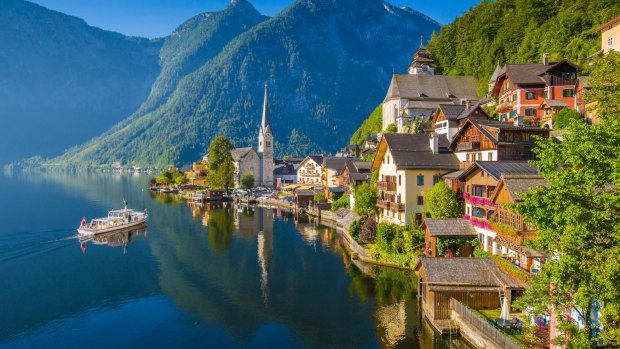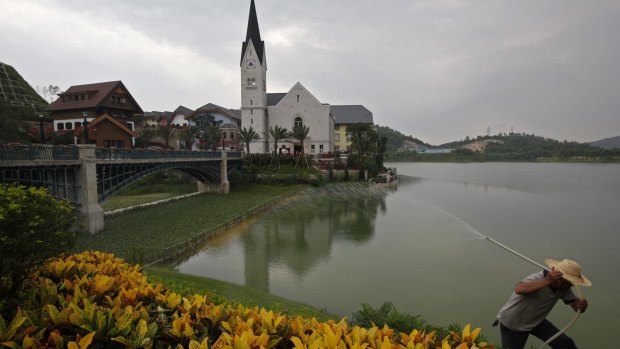This was published 5 years ago
Hallstatt, Austria: Village that inspired Disney's Frozen overrun by tourists
By Greg Dickinson

Hallstatt saw its first spike in popularity back in 2006 when it featured in the South Korean TV show. Soon after, it was marketed across Asia as one of Europe's top tourist destinations.Credit: iStock
The mayor of a tiny Austrian village has begged tourists to stay away, as up to 10,000 daily visitors swarm its streets in search of the perfect photograph.
With a population of 780, Hallstatt has seen a steep rise in visitors from China, Japan, Thailand, Hong Kong and South Korea after it appeared on popular television shows. Ten years ago it received just 100 visitors a day. Now, Hallstatt receives over 1 million visitors per year.
The village, tucked beside a lake and in the shadows of the Salzkammergut mountains, saw its first spike in popularity back in 2006 when it featured in the South Korean show Spring Watch. Soon after, it was marketed across Asia as one of Europe's top tourist destinations.

Then, in 2011, a Chinese mining tycoon spent $1.3 billion building a replica of the village in the southern Guangdong Province.Credit: AP
Then, in 2011, a Chinese mining tycoon spent $1.3 billion building a replica of the village in the southern Guangdong Province, much to the surprise of Hallstatt's residents, who weren't consulted on the project.
The village went on to attract yet more attention as rumours circulated that it was the inspiration for the village of Arendelle in the animated Disney film Frozen, with its Lutheran church standing in for Elsa's castle. The Instagrammers and influencers soon arrived; today, the hashtag #Hallstatt has been used over 615,000 times on Instagram.
Rachel Hosie, columnist at The Insider, visited Hallstatt in October. "Everywhere I looked, people were taking pictures," she said. "Most of the people taking selfies had their backs turned to the view. They simply took their pictures and left."
In November last year, a fire burnt a significant number of the village's 16th-century alpine houses to the ground. Before the fire was out, mayor Alexander Scheutz temporarily closed the roads into the village and issued a statement asking tourists to "stay away".
They didn't heed his advice. The tourists continued to arrive, with smartphones, drones and selfie sticks in tow.
The village earned Unesco World Heritage status back in 1997, at a time when it was visited by a manageable stream of walkers and enthusiasts of Bronze Age history; Halstatt is home to a 7000-year-old salt mine, the oldest in the world.
The boom in tourism has allowed many businesses to stay open throughout the year, and unlike other small Austrian villages it has been able to keep its schools and concert hall going despite a small local population. However, some residents have bemoaned the negative effects of mass tourism.
Verena Lobisser, who owns a hotel in Hallstatt, told the Washington Post: "It's a catastrophe. Many visitors seriously think this is a theme park."
The village has also become prohibitively expensive for locals, as supermarkets and convenience stores prioritise souvenirs over fresh fruit and vegetables. Others have complained that tourists have entered their homes without permission.
Hallstatt is just one of many destinations suffering from so-called "overtourism". On the front-line is Venice, which last year banned large cruise ships from docking at its historic city centre. In its latest measure, Venice is set to introduce a tourist tax as of July 1 2020. Other once-pristine destinations, like Iceland and the Faroe Islands, have also introduced measures to curb the negative impact of their own popularity.
See also: Tourists abandon one of the world's worst countries for overtourism
See also: 'Addicted to cash': Why Venice is dying
Five scenic European towns to avoid the crowds
Annecy (France)
Pitched at the northern tip of the lake of the same name, Annecy is a relatively underrated slice of French Alpine paradise - often passed through, but less frequently investigated, by skiers transferring from Geneva airport to the likes of Courchevel and Meribel. It merits closer inspection, especially during summer, when its nickname - "Pearl of the French Alps" - seems to chime with a definite ring of truth.
Konstanz (Germany)
The idea that Germany is all flatlands and pastures is debunked by its great inland waterside city. "Waterside" is the correct term here, as Konstanz occupies the south end of a peninsula shaped by Lake Constance (or the Bodensee, to deploy the local term) to the east and the Untersee (Lower Lake Constance) to the west - with the River Rhine connecting the two. Plenty of scope for sunset reflections.
Neuchatel (Switzerland)
Its name sounds like a compromise between the German and French-speaking worlds, and so it proves in real life - Neuchatel is the French-speaking capital of the westerly Swiss canton of the same name. It completes something of a titular trio by planting its feet in the north corner of Lake Neuchatel - which, at a swarthy 84 square miles, is the largest lake located entirely in Switzerland.
Klagenfurt (Austria)
Popular perception tends to view Klagenfurt as a ski destination - but while the capital of the Austrian state of Carinthia is certainly a gateway to the pistes in winter, it is also a fine option for summer escapes. It unfurls around Neuer Platz, its heart - but as Austria's sixth largest city, it also stretches east, to the edge of the Worthersee. A three-mile cab ride will carry you to Carinthia's sixth biggest lake.
Ohrid (Macedonia)
A curveball in that its southerly latitude, almost on the border with Greece, probably wipes out any cooling factor accrued from its impressive altitude.
But so beautiful is this tiny fragment of Macedonia – with its churches and houses arranged around the edge of Lake Ohrid – that it has been granted Unesco World Heritage status. It is a place to stand, stare, stroll at a slow pace, and soak up the scenery. - Chris Leadbeater
The Telegraph, London
Sign up for the Traveller Deals newsletter
Get exclusive travel deals delivered straight to your inbox. Sign up now.